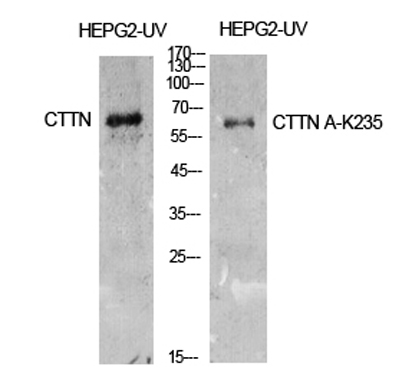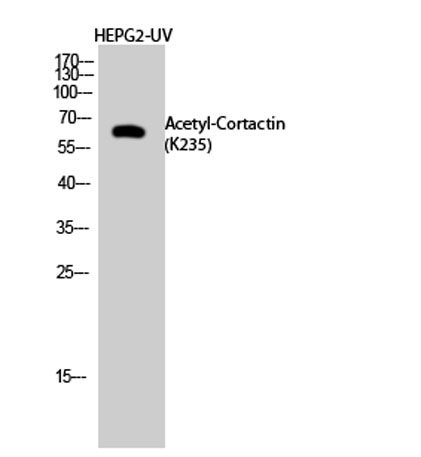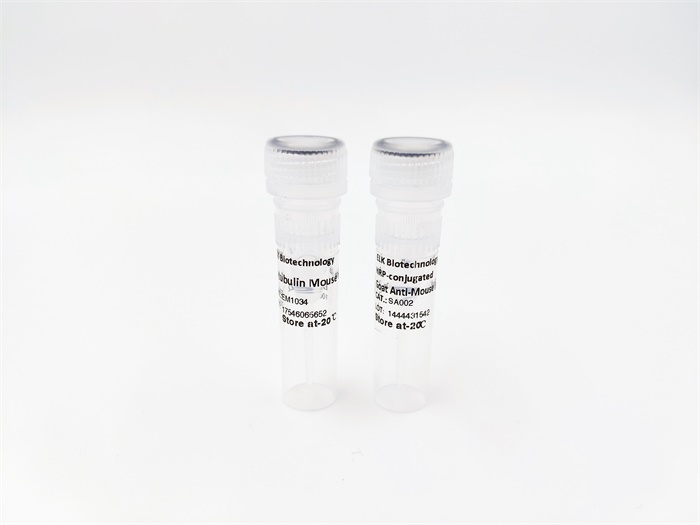







Cortactin (Acetyl Lys235) rabbit pAb
 One-click to copy product information
One-click to copy product information$148.00/50µL $248.00/100µL
| 50 µL | $148.00 |
| 100 µL | $248.00 |
Overview
| Product name: | Cortactin (Acetyl Lys235) rabbit pAb |
| Reactivity: | Human;Mouse;Rat |
| Alternative Names: | CTTN; EMS1; Src substrate cortactin; Amplaxin; Oncogene EMS1 |
| Source: | Rabbit |
| Dilutions: | Western Blot: 1/500 - 1/2000. ELISA: 1/10000. Not yet tested in other applications. |
| Immunogen: | Synthesized acetyl-peptide derived from the Internal region of human Cortactin around the acetylation site of K235. |
| Storage: | -20°C/1 year |
| Clonality: | Polyclonal |
| Isotype: | IgG |
| Concentration: | 1 mg/ml |
| Observed Band: | 62kD |
| GeneID: | 2017 |
| Human Swiss-Prot No: | Q14247 |
| Cellular localization: | Cytoplasm, cytoskeleton . Cell projection, lamellipodium . Cell projection, ruffle. Cell projection, dendrite . Cell projection . Cell membrane ; Peripheral membrane protein ; Cytoplasmic side . Cell projection, podosome . Cell junction . Cell junction, focal adhesion . Membrane, clathrin-coated pit . Cell projection, dendritic spine . Cytoplasm, cell cortex . Colocalizes transiently with PTK2/FAK1 at focal adhesions (By similarity). Associated with membrane ruffles and lamellipodia. In the presence of CTTNBP2NL, colocalizes with stress fibers (By similarity). In the presence of CTTNBP2, localizes at the cell cortex (By similarity). In response to neuronal activation by glutamate, redistributes from dendritic spines to the dendritic shaft (By similarity). Colocalizes with DNM2 at the basis |
| Background: | cortactin(CTTN) Homo sapiens This gene is overexpressed in breast cancer and squamous cell carcinomas of the head and neck. The encoded protein is localized in the cytoplasm and in areas of the cell-substratum contacts. This gene has two roles: (1) regulating the interactions between components of adherens-type junctions and (2) organizing the cytoskeleton and cell adhesion structures of epithelia and carcinoma cells. During apoptosis, the encoded protein is degraded in a caspase-dependent manner. The aberrant regulation of this gene contributes to tumor cell invasion and metastasis. Three splice variants that encode different isoforms have been identified for this gene. [provided by RefSeq, May 2010], |
-
 Western Blot analysis of HepG2-UV cells using Acetyl-Cortactin (K235) Polyclonal Antibody. Antibody was diluted at 1:500. Secondary antibody(catalog#:RS0002) was diluted at 1:20000
Western Blot analysis of HepG2-UV cells using Acetyl-Cortactin (K235) Polyclonal Antibody. Antibody was diluted at 1:500. Secondary antibody(catalog#:RS0002) was diluted at 1:20000 -
 Western Blot analysis of HEPG2-UV cells using Acetyl-Cortactin (K235) Polyclonal Antibody diluted at 1:500. Secondary antibody(catalog#:RS0002) was diluted at 1:20000
Western Blot analysis of HEPG2-UV cells using Acetyl-Cortactin (K235) Polyclonal Antibody diluted at 1:500. Secondary antibody(catalog#:RS0002) was diluted at 1:20000

 Manual
Manual